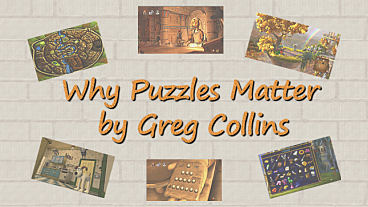
Why Puzzles Matter
Will adventure game players ever again develop a taste for games with the training wheels left off? Unchallenging modern adventure games vs. more challenging classic adventures such as The Secret of Monkey Island.







“ . . . If I could have my way, I’d design games that were meant to be played in four to five hours. The games would be of the same scope that I currently design, I’d just remove the silly time-wasting puzzles and take the player for an intense ride. . . . If any type of game is going to bridge the gap between games and storytelling, it is most likely going to be adventure games. They will become less puzzle-solving and more storytelling, it is the blueprint the future will be made from. The thing we cannot forget is that we are here to entertain, and for most people, entertainment does not consist of nights and weekends filled with frustration.”
Why Adventure Games Suck And What We Can Do About It
Copyright 1989, Ron Gilbert
http://grumpygamer.com/why_adventure_games_suck
The above quotation is from the conclusion of Ron Gilbert’s rather influential essay on what he thought was wrong with adventures at the time he was designing the first Monkey Island games at LucasArts. This was back in 1989, at the very dawn of the now generally accepted “Golden Age of Adventure Games.” In his essay, leading up to this conclusion, Gilbert lays down some rules about what not to do in creating a satisfying adventure. I agree with pretty much all of these rules. And yet, I strongly disagree with the conclusions he draws from them. Because these notions about making unchallenging, short adventures have proven all too prescient.
That quote could be the blueprint of Telltale Games and most of other present day adventure game developers. And of course Gilbert was right in that these simplified, story-driven, short games have brought many more fans to the adventure genre, and have become quite financially successful (well, for adventure games). The problem, as I see it, is that it has primarily brought in only casual gamers, people who for the most part would not be interested in playing a longer, more challenging game, such as The Secret of Monkey Island, and certainly not LeChuck’s Revenge — the games Ron Gilbert was himself creating at the time of his manifesto.
Mr. Gilbert certainly did not remove the “time-wasting puzzles” from either of those first two Monkey Island games. I suspect he’d argue that the puzzles in these games are not time-wasters, that they’re integral to the plot and advance the story, while challenging and entertaining the player. I wholeheartedly agree. The trouble began in the following decade, the 2000’s, when adventure game companies realized that they could essentially do away with puzzles altogether — or, rather, circumscribe them in such a way that they merely appear to be puzzles.
I still vividly remember the first time I ran across this. I couldn’t wait to get my mitts on Telltale’s Wallace & Gromit game. I was happily puttering around Wallace’s house and front yard when I found that I could only go so far. The game was restricting me to a fairly small area, where the first puzzles were to be “solved.” Furthermore, if I delayed even a few moments in completing these simple tasks, the game would rush to my assistance, offering me hints I hadn’t requested. There’s nothing that makes me angrier in an adventure game than being given “help” without my explicit consent. As I say, this is the equivalent of someone “helping” you to eat a chocolate eclair.
After that, matters only got worse. The Telltale simplified puzzle system caught on industry wide and we reached the current state of affairs — the near extinction of the challenging adventure game puzzle.
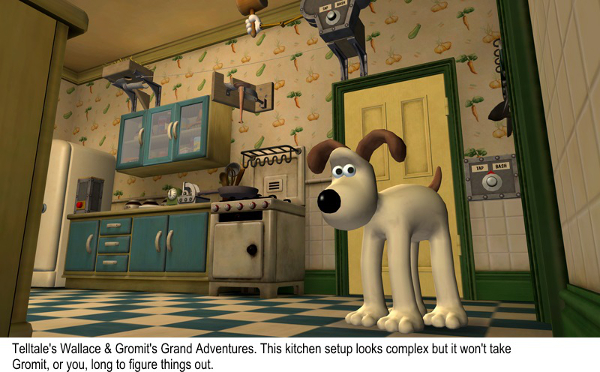
Of course I have been squawking about this like the parrot in Starship Titanic for years now in my reviews. Mostly, I realize, falling on deaf ears. But before puzzling evaporates entirely, I’d like to present my own argument on why I think they remain crucial to the well-made adventure.
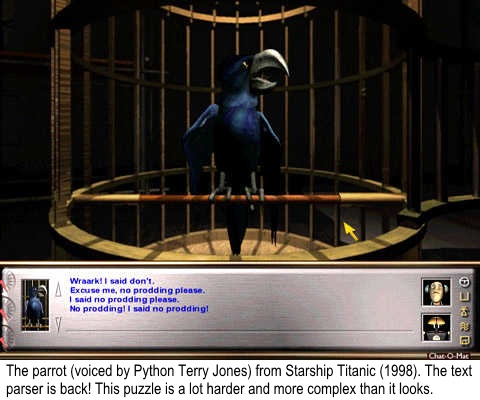
I recently completed two games which I think, taken together, admirably display the points I wish to make, pro and con. The first is the brand new The Book of Unwritten Tales 2, and the second a game from twenty years earlier, Discworld. I consider both of these to be excellent games and I enjoyed playing them both. But the newer game, of course, employs the modern “nursemaid” puzzle philosophy, while the older game decidedly does not.
As I wrote in my recent review, The Book of Unwritten Tales 2 is a beautifully-crafted game, funny and well-written with strong characters. The game’s developers, as was true of the first two games in the series, clearly care about good adventuring and have an obvious respect for the genre’s history. They also went to considerable trouble to create good “classic” puzzles for the game. There are fetch quests and dialog tree puzzles, inventory combinations and even a pure logic puzzle or two, along with a wide array of clues and intriguing areas to explore. But there’s also the restricting mechanics of modern puzzle design. Push the space bar and all the hotspots light up. Use an item in your inventory and it conveniently disappears. The available area to explore at any given time is noticeably curtailed. In short, your choices have been shrewdly confined to a “manageable” few. You can’t really get stuck because it would take only a minute to try every possible combination.
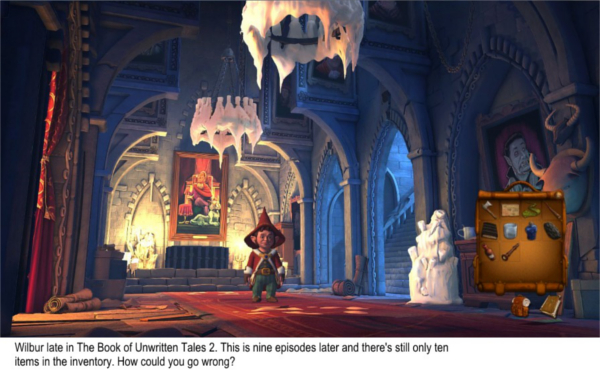
Now, let’s move over to Discworld. By the time you reach Act III in Discworld, you have at least forty items in your inventory, plus a couple of “abilities” that the player character, Rincewind, has acquired. There are at least sixty game screens to visit. The whole world of Discworld is really available to you. To try to solve a puzzle by “brute force” would run into thousands of combinations. Your only real chance of solving a puzzle is to follow the clues.
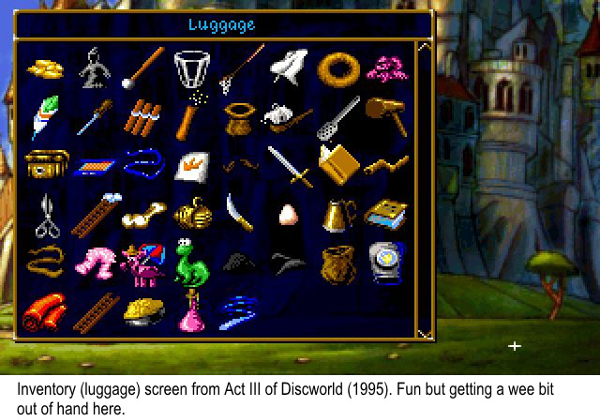
Discworld is an extreme example of the old adventure game puzzle philosophy. It’s the throw them into the lake and let’s see if they learn to swim method. Even I, puzzle fanatic that I am, would not dream of recommending it as a model for other adventure games. I had a great time playing the game, and a great time finally working out all the puzzles, but it took me a couple of weeks and a lot of wandering around aimlessly.
At times the game seems positively to delight in torturing the player — and then taunting him for being stuck. Often, the item you know you need to collect is dangled right in front of you, inches away. But you can’t just pick it up because — well, because then it wouldn’t be a game, would it? Oh no, you have to backtrack across a dozen screens (of course, the handy maps provided for instantly jumping from place to place in a game like The Book of Unwritten Tales 2 are not provided; you have to hoof it) and do something seemingly completely unrelated to your task to start the long string of totally off-the-wall activities you need to do to finally be allowed to pick up your item. Is this fun? Well. yes, often it is.
There’s a fine line between entertainment and irritation in the older, harder adventures. What then, you ask, is the advantage of the more complex puzzles to be found in Discworld? There are two good ones. A tougher puzzle is both more mentally engaging while you’re solving it and personally satisfying once you have solved it. No pain, you know, no gain. The working out of a complex puzzle can be one of the great joys of existence. I am not referring to puzzles that are difficult through poor design. A puzzle can be as tough as it likes so long as it is clever and fair. There are many who would argue the puzzles in Discworld are not fair. That’s not true. They are, at times, quite farfetched — even weird — but after you solve them you quickly recognize their logic. Sometimes, their cleverness alone will bring a grin to your face.
The game designers, in other words, are operating on the theory that players enjoy hunting for clues and making deductions. In his essay Ron Gilbert claims, to the contrary, that such an activity is merely frustrating. Actually, I believe he’s saying that puzzles extraneous to the plot are frustrating. But the current game industry belief is closer to thinking any puzzle that can’t be solved virtually instantaneously is annoying. Who’s right? Puzzle beauty no doubt lies in the eye of the beholder, but when you err too far on either side, I’d argue, you’re in trouble.
“ . . . Overcoming a game’s difficulties isn’t just a matter of practicing until you get good enough; it’s more a matter of thinking about the situation until the right idea finally hits you. That gives a feeling of discovery and achievement that is uniquely close to the satisfaction of solving a real-life problem.”
Compute!’s Guide to Adventure Games
by Gary McGath, 1984
Solving puzzles is fun, and hearing a good story is fun. But stopping to solve a puzzle does interrupt the storyline. The simplest solution to this dilemma would appear to be to keep puzzles and stories separated, like cats and dogs. However, the great adventure game designers, Ron Gilbert among them, discovered that puzzles and story can indeed be magically mixed in a way to provide both kinds of pleasure. In fact, when done properly, each element actually enhances the other. The puzzles add intrigue and tension to the story while the story adds incentive and context to the puzzles. Up to a point.
If the player’s frustration level rises too high, the whole concoction blows up in the designer’s face. It’s a heart-stopping tightrope walk to fashion an adventure game in such a way that a majority of players will make it successfully to the end having enjoyed the whole story and having solved all or at least most of the puzzles. Similarly, if the puzzle complexity falls too low, as in almost all recent adventure games, the concoction likewise fizzles. You’re back to square one, with story and puzzle at odds with each other instead of assisting each other.
Let’s face it, creating games with such perfect equipoise ain’t easy. There’s a reason why classic games like The Secret of Monkey Island are rare. It’s a hell of a lot easier for game designers to chuck the puzzles and cater to the public’s undying affection for pure story. This is the fate which has befallen the adventure game over the past decade and a half. Consequently, players have forgotten how much they like solving puzzles largely because they haven’t had access to games in which the balance of story and puzzle-solving is properly blended.
Which brings me back to The Book of Unwritten Tales 2. Because, perversely, its designers have gone to the trouble of creating a beautiful game with well-integrated story and puzzles. And then they went and undermined their own creation. It’s like training a champion race horse and then encasing its hooves in cement. Why would they do this? Because that’s what the public expects now. After a decade or more of “easy” games, players have become conditioned.
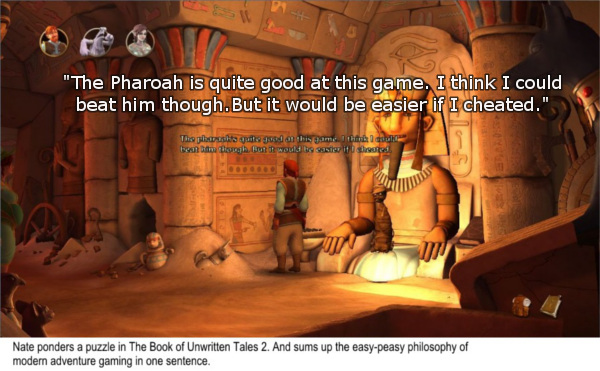
With very little trouble, the gameworld of Unwritten Tales 2 could be transformed into the same garden of puzzle and story delight that exists in the Monkey Island games. My own guess is that this is how the game was originally designed — until its mechanics were “easified” for modern consumption.
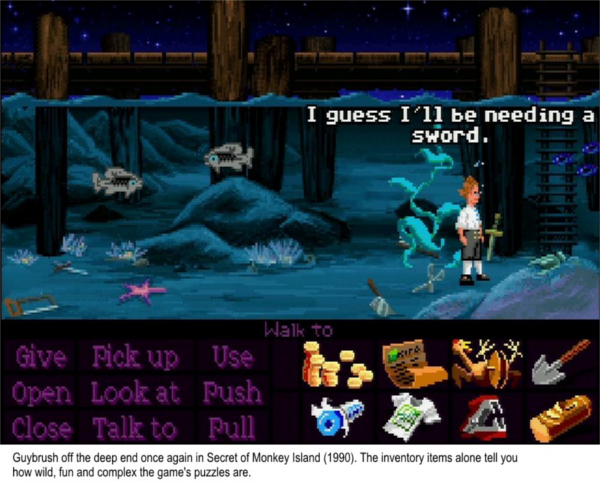
Will adventure game players ever again develop a taste for games with the training wheels left off? One can only hope. It’ll probably take a smash-hit status-quo-buster to shock the public into realizing what it’s been missing all these years. “Oh, my God! [head slap] Good puzzles do enhance the story!”
There’s one thing I count on. People will never lose their interest in good puzzles, just as they’ll never lose their love of good storytelling. They’re sure to respond to any daring confectioner who whips up a delectable meringue of good story combined with intriguing puzzles. If you don’t believe me, then listen to Ron Gilbert in another post to his Grumpy Gamer website, this one from 2013, and in which he muses on “If I Made Another Monkey Island”:
“It would be a hardcore adventure game driven by what made that era so great. No tutorials or hint systems or pansy-assed puzzles or catering to the mass-market or modernizing. It would be an adventure game for the hardcore. You’re going to get stuck. You’re going to be frustrated. Some puzzles will be hard, but all the puzzles will be fair. It’s one aspect of Monkey Island I am very proud of.”
Right on, Ron.
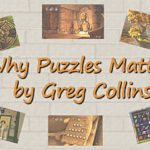
Leave a Reply